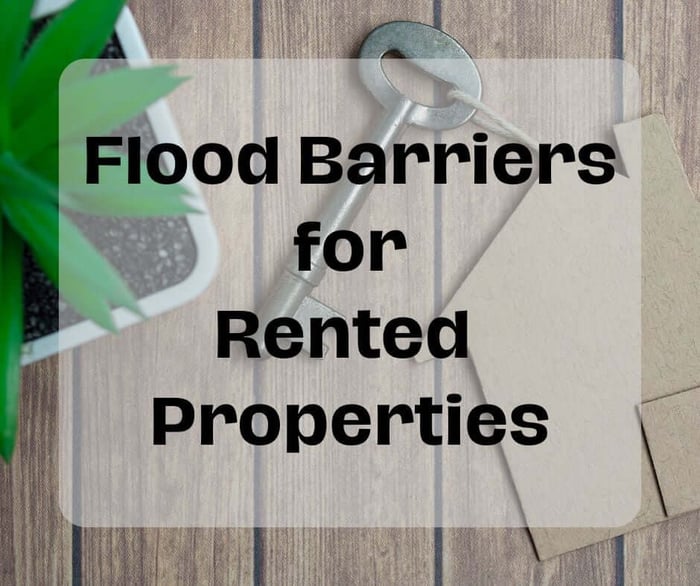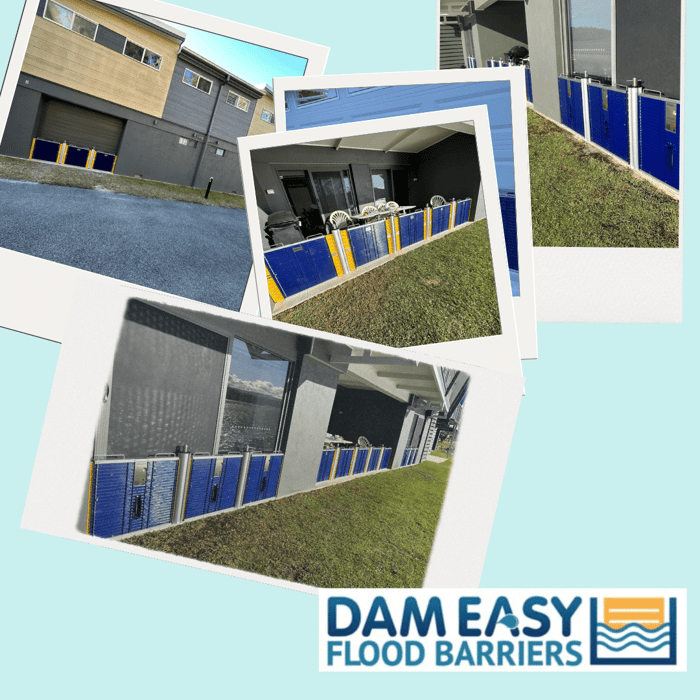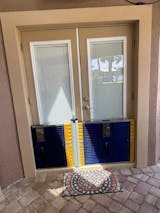Table of Contents
Protecting your rental during floods can feel tricky when your lease forbids permanent changes. The good news: you can take action with temporary, non-invasive solutions. Many modern flood barriers (like the Dam Easy door dams) require “no adhesives, hardware or damaging additions to your home”Dam Easy - Door Dam Flood Barrier - Residential Flood Protection up to 28 inches for Doorways - Amazon.com In practice, you simply position flood barriers in the doorway and inflate it; there’s no drilling or gluing required. For example, Dam Easy notes their barriers “can be installed in under 5 minutes” and don’t need any tools (Dam Easy Flood Barriers - Flood Gate). Because these systems leave virtually zero trace (just a flush mounting frame or gasket), they usually don’t count as a permanent alteration – your deposit stays safe if you remove it and restore the area afterwards.
Of course, every lease and locale is different. Legally, most rentals forbid major modifications, but many places allow minor, reversible fixes. In California, for instance, tenants are typically allowed to make small repairs (up to a certain dollar limit) so long as they can undo them (Renters insurance doesn’t cover floods, surprising some tenants during climate disasters - Streetlight). In NSW and most other regions, the rule of thumb is: if it doesn’t leave holes or marks and you put it back exactly as found, you can often get away with it. Always talk to your landlord upfront (see questions below). Sometimes just highlighting that these flood barriers protect their property too can win approval. Remember: official NSW guidance even reminds renters that after a flood, they remain responsible for their own stuff – landlords aren’t required to pay for your damaged belongings (Landlords' and tenants' rights after an emergency | NSW Government). Keeping water out is in your interest and theirs.
Quick Tips: To stay deposit-friendly, choose removable options like inflatable door dams or sandless bags. Use weatherstrips or temporary flood socks on door thresholds. Attach any anchors only with removable screws or powerful suction pads. And document everything – take “before” photos of the empty doorway so you can prove no paint or framing was harmed. Finally, when the storm threat passes, fold the barrier away: products like Dam Easy collapse to a flat profile for easy under-bed storage (so they won’t clutter your unit).
Flood Prep Fact: FEMA reminds us that “Flooding remains the country’s number one disaster and can potentially affect everyone and every property” (Know Your Flood Risk: Homeowners, Renters or Business Owners | FEMA.gov). Renters must take this seriously – flood insurance and preparation are not optional.
Dam Easy Flood Barriers vs. Sandbags vs. Permanent Barriers
Choosing a flood defense is a balancing act between cost, convenience, and lease concerns. Here’s a quick comparison:
| Barrier Type | Cost | Setup Time | Landlord Approval? |
|---|---|---|---|
| Dam Easy (door dam) | ≈$1,000 (one-time, reusable) | ~5 minutes (Dam Easy - Door Dam Flood Barrier - Residential Flood Protection up to 28 inches for Doorways - Amazon.com) | No permission needed (non-drilling, non-damaging) |
| Sandbags | Very low (bags + sand) | Labor-intensive (30+ min per door) | Depends – heavy, messy installation often needs OK |
| Permanent Wall/Flood Barriers | Very high (contractor) | Days/weeks (permits & build) | Generally not allowed in rentals |
Dam Easy Flood Barriers: A turnkey solution designed for just this scenario. It’s expensive upfront, but reusable. As a renter, you benefit from its quick deployment and deposit-friendly design. According to the maker, Dam Easy “does not require any tools” and seals doorways watertight by simply inflating a gasket . When not in use, the unit collapses flat. Unlike sandbags, there’s no heavy lifting, cleanup or biohazard risk. You can install it solo in under five minutes and pack it away with zero residue. In short, Dam Easy offers speed and simplicity: it’s ready to go when storm warnings come.
Sandbags: The classic choice is cheap per barrier, but far from hassle-free. Empty bags store flat, and sand is free – a big advantage (Sandbag - Wikipedia). However, filling dozens of sandbags is backbreaking work, often requiring help or tools. Wikipedia notes sandbag walls can “fail at a lower height” if done wrong, and even after use they “can degrade prematurely” or become contaminated by sewage (Sandbag - Wikipedia). You’ll also have to haul wet, heavy bags out later, which can damage floors and walls. In short: sandbags are economical, but unwieldy and messy. Many landlords (even well-meaning ones) worry about the weight and mold risk of sandbags inside a unit. They’re a last resort in a rental.
Permanent Barriers (e.g. custom flood gates): These are highly effective but usually out of reach for renters. Building a concrete or mechanical flood wall can cost many thousands and needs professional installation and permits. You can bet any lease explicitly forbids such a modification (and it would certainly void your deposit if you tried!). In a rental, permanent fixtures aren’t an option. Stick to portable, non-invasive gear.
DamEasy防洪闸门坝 -终极防洪

$899.00
大坝容易®防洪闸门大坝 洪水在世界各地越来越普遍。曾经的百年现象,现在是房主必须面对的季节性趋势。 这正是为什么你需要这个大坝容易防洪闸门大坝! 作为重型和凌乱沙袋的一个很好的替代品,这个屏障提供了第一道防线,防止水进入你家的门窗。当洪水发生时,快速行动的能力至关重要。此防洪屏障可在 5 分钟内安装,为您提供可靠的防洪保护! 不要等到为时已晚。得到这个防洪屏障门坝,现在保护你的房子! … Read More
Figure: Dam Easy Flood Barriers (cross-section diagram). Unlike sandbags, the Dam Easy barriers have carry handles, a built-in pump, side extensions and replaceable seals. It extends to fit wide doorways and inflates to seal against water, yet folds down for compact storage.
“I live in a ground-floor Sydney apartment and was terrified when last year’s floods hit. I set up portable door flood barriers in minutes before I left for work – it kept all the water out! My landlord never even noticed I had it, and everything inside stayed dry. I got my full deposit back!” – Jane, Sydney renter
What else can I do to prepare my rental for floods?
Flood defenses go beyond barriers. Start early: know your risk and pack a flood prep kit. Secure anything that can’t get wet, and make a plan. Here are some renter-friendly tips:
Elevate Valuables: Move electronics, important papers and small appliances up onto shelves or counters. Even a 6‑inch elevation can save them. Store documents in sealed plastic bags or tote bins.
Document Your Space: Take photos/video of your carpets, furniture and contents. If damage occurs, you’ll have evidence for insurance or refund claims.
Use Door Seals: Besides Dam Easy, simple tools like self-adhesive draft stoppers, removable flood socks, or silicone caulk can plug cracks at low cost. These seal gaps without screws or drills.
Keep an Emergency Toolkit: Maintain supplies in one spot (a closet or under a sink). Include a flashlight, portable radio, extra batteries, first-aid kit, and a phone charger/battery pack. Also store gloves and a broom to help clear water.
Trim Your Trees: If you have tenant permission, remove loose branches outside to reduce debris during a storm.
Learn Your Alert Systems: Sign up for flood warnings (e.g. FEMA and local alerts) and know evacuation routes.
Flood Insurance Stat: Only about 27% of U.S. homeowners had flood insurance in 2020 – and even fewer renters do (Renters insurance doesn’t cover floods, surprising some tenants during climate disasters - Streetlight). Remember, standard renters insurance almost never covers flood damage (Renters insurance doesn’t cover floods, surprising some tenants during climate disasters - Streetlight). If you care about your stuff, consider a separate flood policy.
5 Questions to Ask Your Landlord Before Flood Season
By opening a respectful dialogue, you gain support and clarify expectations. Try asking:
“Are there any built‑in flood defenses or drainage systems at the property?” (Knowing sump pump locations or exterior barriers helps.)
“What is the procedure for emergency repairs if water enters?” (Should you hire a plumber or wait for them?)
“Can I use a non‑permanent flood barriers or door seal to protect the apartment?” (Explain how it won’t damage the unit or violate the lease.)
“Do you carry insurance for flood damage to the building?” (Not tenant insurance, but building coverage.)
“How do you handle rent or lease terms if the rental is temporarily uninhabitable after a flood?” (This can clarify if rent is reduced or paused.)
All of these questions make you look proactive, not paranoid. You might even offer to help arrange repairs post-storm.
Here's an email template to send your landlord:
Subject: Flood Season Preparedness for [Your Address]
Hi [Landlord Name],
I hope you’re doing well. With heavy rains predicted this season, I’d like to discuss simple steps to protect the apartment from flooding. I’m considering using temporary door flood barriers (a low-profile seal) at the entry when needed. It installs in minutes without drilling or adhesives, so the doorframe remains untouched. This would help keep water out while still being completely removable after the storm – so it won’t affect the property or my deposit.
I wanted to check that this would be okay with you. I believe it’s a smart precaution that safeguards both our interests, preventing water damage to the unit’s floors and walls. Of course, I’ll follow any guidelines you have and restore everything afterward.
Please let me know your thoughts. Thank you for considering this safety measure!
Best regards,
[Your Name]
Free Renter’s Flood Prep Kit Checklist
Gather these essentials now, before a storm hits:
Photos + Inventory: Snap pictures of rooms and valuables; list serial numbers. Store this info off-site (e.g. emailed or in cloud) in case your home is damaged.
Sealants & Strips: Buy removable weatherstripping, silicone caulk and door threshold seals (often found at hardware stores) – all easy to apply and remove later.
Elevators: Use bricks, wood blocks or sofa cushions to lift furniture at least 6 inches off the floor. Even 4×4 timbers under table legs can keep items dry.
Waterproof Containers: Put important docs (passports, deeds) in a ziplock box or plastic bin that you can grab quickly. Keep cash on hand in case ATMs fail.
Emergency Gear: Flashlight(s) with fresh batteries, a battery-operated radio, bottled water, non-perishable snacks and a basic first-aid kit. If you have a battery back-up or generator, keep it fueled.
Temporary Barriers: Store a few sandless flood bags or a compact flood flap in a closet. These can be laid down quickly under doors if warnings come. (Even a rolled bath towel can help stem minor seepage.)
Drain Down Plan: Locate and practice turning off the building’s main water valve, electric box, and any gas lines, so you can quickly shut down utilities if flooding threatens.
By assembling this kit and discussing plans with your landlord, you’ll be empowered – not panicked – when heavy rain hits. Taking these steps helps keep you in control of your space and your deposit.
Sources & Further Reading
FEMA, “Know Your Flood Risk: Homeowners, Renters or Business Owners” guide (Know Your Flood Risk: Homeowners, Renters or Business Owners | FEMA.gov).
Insurance Information Institute – statistics on flood insurance coverage (Renters insurance doesn’t cover floods, surprising some tenants during climate disasters - Streetlight).
NSW Government, “Landlords’ and tenants’ rights after an emergency” (renters’ rights after floods) (Landlords' and tenants' rights after an emergency | NSW Government).
Wikipedia – Sandbag (entry on flood-control sandbags) (Sandbag - Wikipedia).
NASA/NOAA climate reports on flooding trends.




















